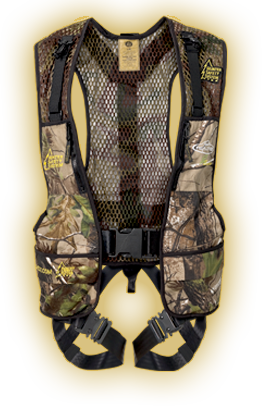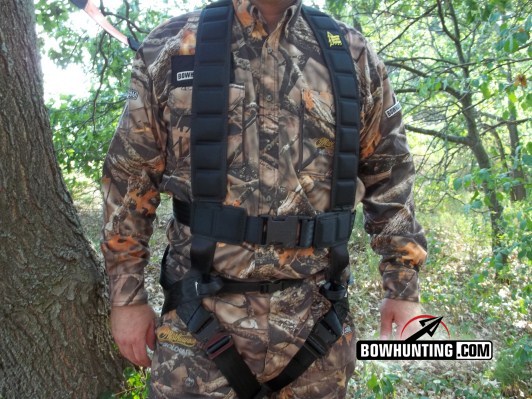LAST UPDATED: May 1st, 2015
Treestand safety is a subject often touched on, albeit briefly, in many hunting discussions. However the importance of proper safety while treestand hunting cannot be stressed enough. Essentially, there are two types of treestand hunters; those who have fallen, and those who haven’t fallen yet. Every hunter that I have ever questioned knows someone who has fallen from a treestand. I myself had a close call last season.
I was climbing into my stand for a typical morning hunt. The particular stand I was hunting had been in the tree for a few years. When I stepped onto the platform, one of the steel cables securing the foot platform to the riser against the tree broke, pitching me out of the stand! I was very fortunate that I was able to catch myself on a tree limb and climb down without being injured. However, many hunters are not so lucky. Hundreds of hunters fall every year. Some are seriously injured, while others are killed.
I can’t stress enough that proper treestand safety involves many different things. I am going to examine these points in order to ensure that everyone reading this gains a clear understanding of proper safety. After all, our ultimate goal each time we enter the woods should be to make it back home to the ones we love and those who love us.
Wearing a safety harness will help ensure you return home after every trip into the woods.
The Must Have
The first piece of safety equipment every hunter MUST have and use EVERY time they hunt from a treestand is a good safety harness. Many of you may groan when you hear that. I feel your pain. Up until the past few years most safety harnesses were cumbersome, complicated, uncomfortable, and heavy to say the least. Luckily, that has all changed. Many manufacturers now offer harnesses that are light weight, comfortable and user friendly.
Newer models like the UltraLite and Hybrid from Hunter Safety System are a pleasure to wear. They are also versatile, which means they can be worn either inside or outside your hunting coat. In addition, they come in many different camo patterns to match your hunting clothing. What more could a bowhunter ask for?
Harness Options
The Basic Safety Harness
When it comes to choosing which harness is best for you, there are several basic options. First, consider the safety harness that comes with every treestand sold. Chances are good you have a pile of these collecting dust in a corner somewhere. I know I do. These harnesses, while not my favorites, are certainly adequate for keeping you safe while bowhunting from an elevated position. They are tested and approved by the TMA and usually made of either elastic or thick cloth straps and may have either buckles, snaps, or pull tension straps for closures.
If price is an option, then they can’t be beat since they are basically “freebies” every time you buy a treestand. If you don’t have one, chances are you’ve got a buddy that will give you one. But if you plan on logging a lot of hours in a treestand, you will quickly realize that those types of harnesses are not designed for repeated long term use. They are not exactly designed with a hunter’s comfort in mind. This is where higher quality safety harnesses come into play.
When hanging stands, don’t forget to use a lineman’s belt to ensure safety.
 The Safety Vest Harness
The Safety Vest Harness
The vest style safety harness looks more like a hunting jacket than a harness and usually has camo fabric front and back. The harness is basically sewn inside the vest. You simply put on the vest like a jacket and attach the front buckles and leg straps. A good number of hunters prefer the vest-style because they allow the user to carry many accessories in the pockets for quick access while hunting.
The nice thing about vest style harnesses is they usually have lots of pockets and straps to carry your gear. Many have built in rangefinder pockets and lanyards for attaching calls which allows you to keep everything within easy reach while on stand. Most importantly, they are much more comfortable for an all-day sit than the free harnesses previously discussed. The straps are wider and have considerably more padding and the safety lanyards are usually longer, giving the hunter more freedom to move in the tree. The only drawbacks to vest style harnesses is the extra bulk that accompanies them or wearing them in hot weather.
However, companies like Hunter Safety System have gone through great lengths to streamline the size and weight of the vest style harnesses to make them more enjoyable for the hunter to wear for long periods of time. The Pro-Series safety harness features a mesh material that is light weight and breathable, while still oferring plenty of pockets for gear storage.
Standard Design Safety Harnesses
The next option is what I refer to as a “standard harness”. These are typically similar to a vest style in that they have lots more padding, longer lanyards, and are much easier to put on and attach to the tree than the harness which is included with your treestand. The difference is they are usually lighter and take up less room than a vest, making them slightly more versatile. Most weigh between one and two pounds which allows you to wear them for extended periods of time without even knowing they’re on.

The minimal design and light weight of the Hunter Safety System UltraLite harness has made it a favorite of the Bowhunting.com video staff over the past year. It’s light weight design allows for increased comfort and greater mobility.
The downside to standard design harnesses is that they don’t have accessory pockets to carry any of your hunting gear. Some models do include binocular straps which can really come in handy for those who prefer to wear their harness on the outside of their jacket. Harnesses such as the Hunter Safety System Ultra-Lite fall into this category. This style has become my personal favorite over the years.
Hybrid Design Safety Harnesses
A fourth option is a hybrid of both the Vest and Standard design harness. This particular design has ultra-lite construction, with no bulky vest, but still has pockets around the bottom for a hunter’s gear. While these types of harnesses are relatively new on the market, they’re already becoming a quick favorite of bowhunters as they provide the best of both worlds.
All of these harnesses can be washed with your other hunting clothing to remain scent free as well. However, in order to be effective, no matter which harness you choose, wear it on every single hunt. No harness can save your life unless you are wearing it.
In and Out
While safety harnesses have been the primary focus of our discuss so far, what many people don’t realize is that the majority of treestand accidents happen either while climbing up to or down from your treestand. In fact, over 80% of all treestand falls occur while climbing, not while sitting.
So, how do we stay safe when the vast majority of treestand accidents happen getting into or getting out of the stand? The answer to that question is relatively simple, and it’s called a LifeLine. Several companies are now offering products that will keep a hunter attached from the time he/she leaves the ground until the time they return to it.
The “Lifeline”, by Hunter Safety System, allows hunters to be attached even while climbing and entering their treestand.
The model I will be using this fall is the “Lifeline” from Hunter Safety System. The “Lifeline” is a 30 ft. section of rope that the hunter attaches above the treestand and ties-off at ground level. A Prusik knot on the rope allows the hunter to attach his lanyard to the rope while still on the ground and slide the knot up as he/she climbs the tree. This allows the hunter to remain attached when they reach hunting height and does not have to worry about falling while entering or exiting the stand. This is an excellent product, and will essentially prevent any hunter from falling while climbing and entering/exiting the stand. My personal recommendation is to place one of these potentially life-saving devices in every treestand you own.
Preventing Mechanical Failures
A good rule to live by is to remember that general care & maintenance must be taken when hunting in order to minimize accidents. This includes inspecting all equipment regularly. Even if the equipment is new, you’re never really sure what has happened while you were away. For example, a friend of mine learned this lesson the hard way last fall. He was climbing into his stand early one morning, and when he placed his weight on the stand platform it fell out from under him and he fell 20 feet. Lying in the hospital, he struggled to understand how the treestand fell because he had just hung it a few weeks prior. Upon further examination, someone had cut the strap on his stand while he was gone. The lesson…..never trust your equipment until you verify it is in safe working order.
In addition, follow the 3 point rule of treestand safety which says that you should always have 3 points of contact to the steps or ladder when climbing. This could be two arms and one leg holding and stepping on the ladder or one arm and two legs in contact with the ladder before moving. Also, be cautious of rain, frost, ice, or snow that can cause steps to become extremely slippery, as well as check the security of the step or stand before placing your weight on it.
Common Sense
Use good judgment. If something doesn’t look safe, don’t use it. “When in doubt, back out” doesn’t just apply to recovering game; it also applies to treestand safety. If something looks worn out, replace it. Saving a few dollars isn’t worth your life or having a serious accident. Also, always make sure to tell someone else where you will be hunting and when to expect you back. A cell phone is also very helpful to call for assistance if necessary.
Remember, use your head when it comes to safety and don’t take any chances with your life……it isn’t worth losing.
Being safe while treestand hunting does not mean you have to give up comfort or convenience. There are many products available that will make staying in the stand and staying safe, easier. This, coupled with plain old common sense and being careful, is a good recipe for success. If you feel safe while you are hunting, you can concentrate more on the hunt; instead of worrying about your safety every time the wind blows. This hunting season; hunt hard, hunt high, but most of all, hunt safe!






